Equilibrium Positions for UAV Flight by Dynamic Soaring
Abstract
Dynamic soaring is a special flying technique designed to allow UAVs (unmanned aerial vehicles) to extract energy from wind gradient field and enable UAVs to increase the endurance. In order to figure out the energy-extraction mechanisms in dynamic soaring, a noninertial wind relative reference frame of aircraft is built. In the noninertial frame, there is an inertial force which is created by gradient wind field. When the wind gradient (GW) and the components of airspeed (vzvx) are positive, inertial force (F) makes positive work to the aircraft. In the meantime, an equilibrium position theory of dynamic soaring is proposed. At the equilibrium positions, the increased potential energy is greater than the wasted kinetic energy when the aircraft is flying upwards. The mechanical energy is increased in this way, and the aircraft can store energy for flight. According to the extreme value theory, contour line figures of the maximum function and the component of airspeed (vz) are obtained to find out the aircraft’s lifting balance allowance in dynamic soaring. Moreover, this equilibrium position theory can also help to conduct an aircraft to acquire energy from the environment constantly.
1. Introduction
Long endurance flight is a key design criterion for unmanned aerial vehicle [1]. The UAVs’ flight endurance can be improved by the progress in power capacity and aerodynamic and engine design [2], but not all such means are equal. Another important alternative for enhancing UAV flight endurance is to seek energy from flight environment. In nature, there are many large-sized birds which make use of environment energy to enhance their flight ability, such as wandering albatross who extracts energy from horizontally moving air and transfers energy to itself. The achieved energy enables wandering albatrosses to fly continuously without flapping their wings [3, 4]. The flight manoeuvre that wandering albatross performs is referred to as dynamic soaring [5]. Early in 1883, Lord Rayleigh published “The Soaring of Birds” in Nature [6], which is regarded as the first paper about dynamic soaring. Dynamic soaring is possible when there is horizontally moving air in the flight environment. Horizontally moving air is also called gradient wind, in which wind speed varies with altitude. In this paper, both the size of the wandering albatrosses with its 3.3 m wing span and its flight performance are taken as a reference model against the dynamic soaring performance of a small UAV.
Dynamic soaring is an important flight technique designed to allow aircraft to extract energy from atmosphere. Based on Lord Rayleigh’s observations of albatrosses in the south Atlantic, more recent publications are concerned with wind estimated and dynamic soaring mechanism. In order to estimate wind field for autonomous dynamic soaring, Lawrance et al. [7, 8] provided a method for taking direct observations of the wind during flight and creating a wind to direct future exploration. The wind estimation is the precondition for dynamic soaring. In this paper, a mathematical model is built for the wind field. As for dynamic soaring mechanism, Grenestedt [9] provided insight into how and where energy is extracted from the wind during dynamic soaring. The effects of some aircraft parameters such as mass, drag area, and wing span were discussed. Bower [5] studied the energy transfer mechanisms for a vehicle flying in a spatially and temporally varying wind field. Deittert et al. [10] investigated optimal trajectories for minimal and maximal wind conditions, and the likelihood of favorable winds was predicted based on long-term weather statics and knowledge of minimal and maximal permissible wind strengths. Cone [11] analyzed the dynamic soaring flight of albatross with mathematical models. Peter [12] draw a conclusion that, in an energy neutral cycle of dynamic soaring, whether the vehicle returns to initial velocity and height with no power input depends only upon the maximum lift-to-drag ratio of the vehicle and the wind speed variation.
Scores of research findings reveal the significant meaning of dynamic soaring. Based on the achievements of these findings, some new ideas are studied in this paper. The authors first extend the idea of Grenestedt [9] by investigating the equilibrium position of dynamic soaring and providing insight into energy variation in equilibrium position. The same as other flight styles, they applied forces on the aircraft for dynamic soaring varying continuously. Then there should be some positions of forces balance in the course of flight. At these points, the aircraft stays in a certain speed, with no kinetic energy loss. Of course, if all the points could chain a closed route, the permanent flying would come true when the aircraft flies along the route.
The rest of the paper is organized as follows: the methodology is described in Section 2, including the wind gradient and the mathematical models for the UAV. Section 3 is simulation results and associated discussion. Finally, the concluding remarks are made in Section 4.
2. Mathematical Formulations of the Problem
Inspired by the forces analysis methods in dynamic soaring suggested by Bower [5] and Deittert et al. [10], the problem of equilibrium position for dynamic soaring is analyzed intensively in this paper. The parameters that can influence the equilibrium position include the range of airspeed, the size of wind gradient, and other parameters. Meanwhile, the maximum value of energy acquired in the equilibrium point is analyzed. Once the parameters of an aircraft are known, the wind gradient suited for the equilibrium position of dynamic soaring can be determined. Similarly, in a known wind field, the type of aircraft that has equilibrium point in dynamic soaring can be found out. A set of computational methods for equilibrium position of dynamic soaring is established. The purpose of this section is to provide a theoretical guidance for the optimal dynamic soaring trajectory by means of the analysis of equilibrium position of dynamic soaring. Due to no kinetic energy loss in the position of forces balance, the mechanical energy increases with increasing value of potential energy of the aircraft in the course of upward flying.
2.1. The Wind Field Model

Figure 1 shows the wind profile and wind gradient profile for value of the roughness coefficient with Wref = 15 m/s, zref = 100 m, and z0 = 0.05 m.
2.2. Flying Model
According to the observed data of dynamic soaring [4], the albatross climbs with headwind, and the wind speed increases with the increasing of flight height. After turning in high altitude, the albatross glides with leeward, and the wind speed decreases with the descending of flight height. An illustration of a typical dynamic soaring trajectory is shown in Figure 2.
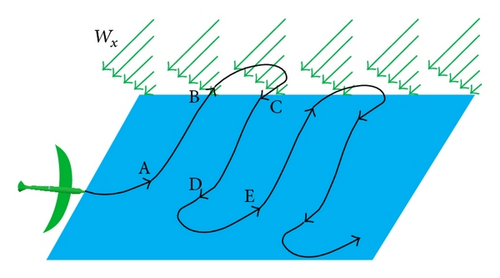
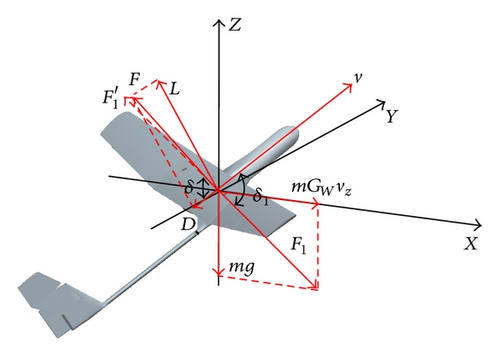
When the value of F is equal to , the relationship between v and vz can be attained by (10).
2.3. The Balance Points of Dynamic Soaring
With the geometrical relationship of forces balanced, one can acquire the space curve of vx × vy × vz, which is obtained by projecting the four-dimensional space vx × vy × vz × ψ into three-dimensional space. The fundamental is to find out a suitable aerodynamic force to compensate the resultant force of gravitation and inertial force.
3. Simulation Results and Discussions
Because there is no closed form solution for the balance points in dynamic soaring, numerical investigations are carried out instead. As dynamic soaring flight is directly inspired by albatross, wandering albatross’ parameters used by Sachs [4] are assumed. Based on the architecture of a wandering albatross, an aircraft demonstrator model is used as a reference. The UAV demonstrator has similarities in dimension as well as the performances with albatross. This will ensure that the performances of the aircraft model are achievable by an engineering-designed vehicle. The parameter values of albatross and UAV demonstrator are given in Table 1, where Emax is the maximum lift-to-drag ratio. Compared with the albatross, the UAV demonstrator has a lighter mass. Furthermore, the flying ability close to the ground surface of the UAV demonstrator is limited, while albatross can fly with a wing tip touching the water. For the reason of security, the UAV demonstrator has a smaller wingspan. The aerofoil of UAV demonstrator is E214, which makes the vehicle have a better performance than albatross, reaching a maximum lift-to-drag ratio of 21.
| Parameter | Albatross | UAV demonstrator |
|---|---|---|
| Mass [kg] | 8.5 | 5.5 |
| Wing area S [m2] | 0.65 | 0.68088 |
| Aspect ratio | 16.81 | 16.81 |
| Span [m] | 3.306 | 2.61 |
| ρ [kg/m3] | 1.22 | 1.22 |
| CD0 | 0.033 | 0.033 |
| Emax | 20 | 21 |
From (26), it can be found that the relationship between variables cos(δ) and cos(ψ) is linear and the value of cos(ψ) is located in the interval [−1,1], so the range of cos(δ) can be defined. The extent of albatross’ vz and UAV demonstrator’s vz is shown in Figures 4 and 5, respectively.
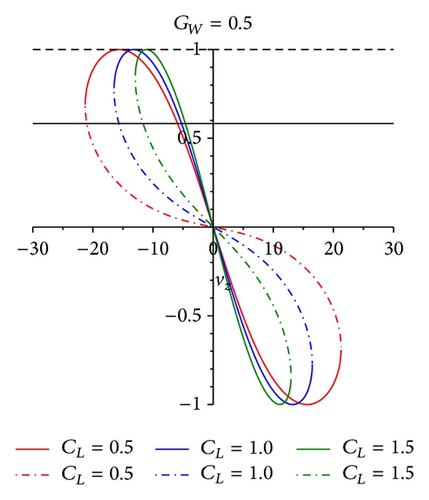
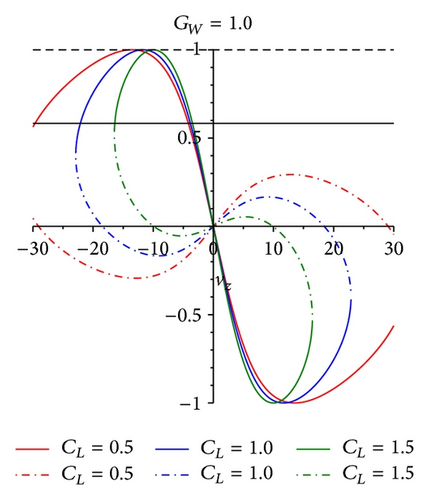
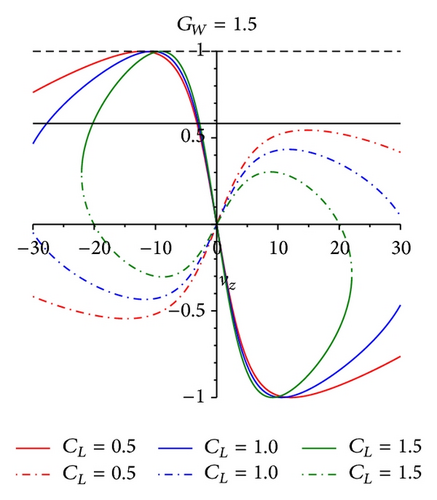
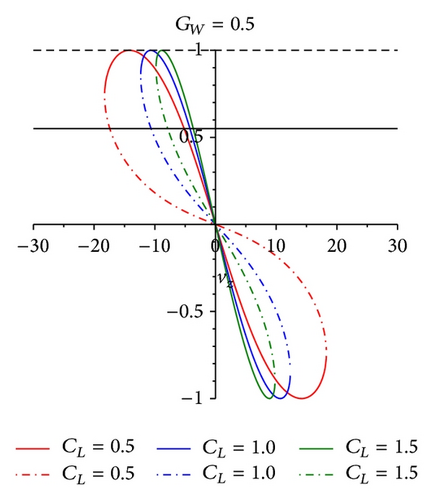
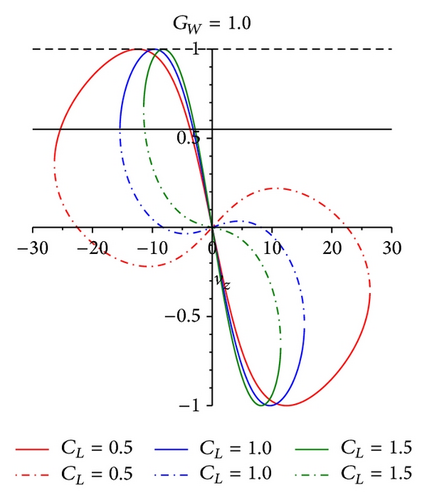
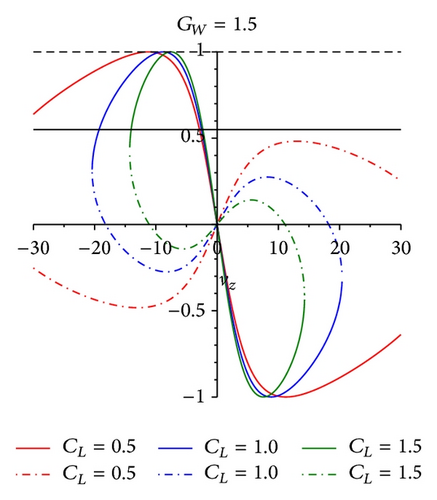
The contour line figure of albatross’ maxf and vz max is expressed in Figures 6 and 7.
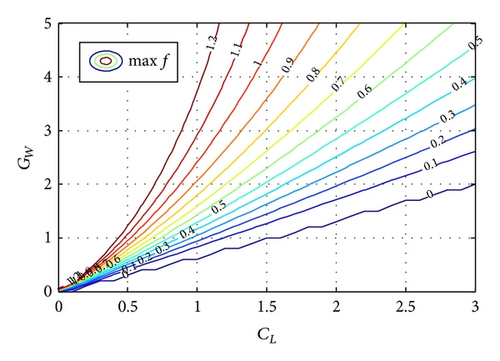
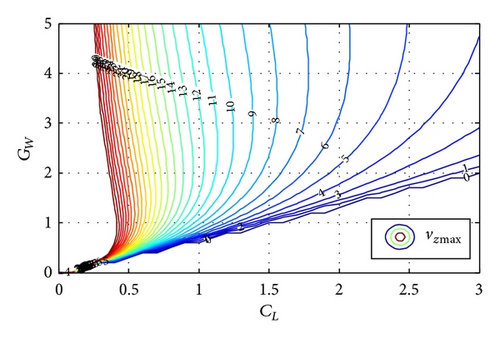
The contour line figure of UAV demonstrator’s maxf and vz max is expressed in Figures 8 and 9.
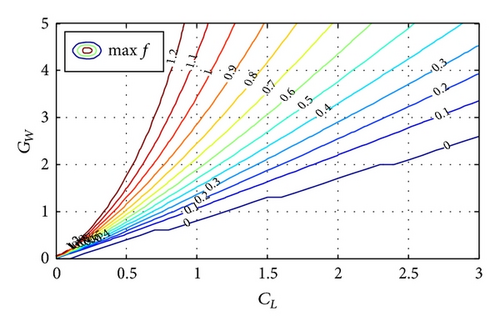
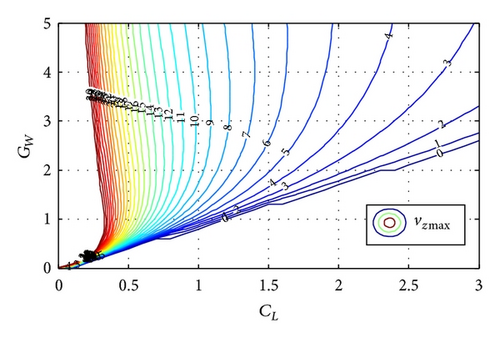
From Figure 6, it is obvious that maxf has many values greater than zero. That is to say, (31) has reasonable solutions. From Figure 7, the maximum value of vz for the albatross’ lifting balance allowance in dynamic soaring can be found. For example, if the lift coefficient of albatross (CL albatross) is 1 and the gradient of the wind field (GW) is 1, in Figure 6, the value of maxf is 0.4. Compared with Figure 7, vz = 9 m/s; combining with (20), it can be found that v = 17.0 m/s. That is to say, when albatross’ airspeed reaches 17.0 m/s, there exists equilibrium point in this wind field. Just getting the value of airspeed is not enough to make conclusions. The restriction to airspeed is the bank angle of air velocity vector, which is defined as ψ. With the geometrical relationship of forces balanced, one can acquire the space curve of vx × vy × vz, which is obtained by projecting the four-dimensional space vx × vy × vz × ψ into three-dimensional space. The fundamental is to find out a suitable aerodynamic force to compensate the resultant force of gravitation and inertial force. From (24), (25), and (26), the value range of the bank angle is [30°, 60°]. The albatross can reach the equilibrium position in gradient wind under these limiting conditions. Similarly, the equilibrium points for UAV demonstrator in dynamic soaring can be found in Figures 8 and 9.
4. Conclusions
Dynamic soaring gives the albatross an ability to achieve energy from the environment and prolong its flight endurance, which is a guide to consider using dynamic soaring as a propulsive energy source for small UAVs. The paper presents an equilibrium position theory of dynamic soaring which is the forces balance during the flight. At the equilibrium position, the aircraft stays in a certain speed without kinetic energy loss. When the flight direction is upward, the mechanical energy would increase, which can store energy for flight.
In this paper, the wind relative reference frame of aircraft is noninertial, and the inertial force F created by wind can be used to do work for aircraft. In the noninertial frame, the mechanical energy variation of the aircraft equals the energy caused by drag and inertial force. When the wind gradient GW > 0 and vzvx > 0 (vx, vz are the airspeed component in the direction of positive x-axis and z-axis), the inertial force (F) does positive work to the aircraft. The mechanical energy variation for unit mass is influenced by wind gradient, mass (m), and drag coefficient.
Because of the existence of the gradient wind field, there are some balance points during dynamic soaring no matter how parameters are chosen. In the contour line figures of albatross’ maxf and vz max, it is easy to find out that the maximum value of vz albatross, lift coefficient (CL albatross), airspeed (v), and bank angle (ψ) and the gradient of the wind field are required by the dynamic soaring balance points. By means of performances comparison between UAV demonstrator and albatross, it is manageable to apply dynamic soaring in engineering practice.
Finally, in order to make dynamic soaring profit from further research work as soon as possible, dynamic soaring experiments are necessary. Furthermore, an investigation with theory of balances for 6 DOF aircraft model would be helpful for instructing the dynamic soaring experiments.
Conflict of Interests
The authors declare that there is no conflict of interests regarding the publication of this paper.
Acknowledgment
The authors gratefully acknowledge the financial support from the Fundamental Research Funds for the Central Universities (Project no. CDJZR14325501).




